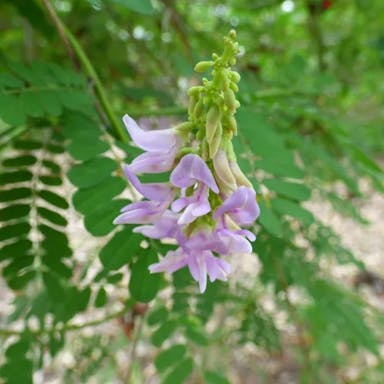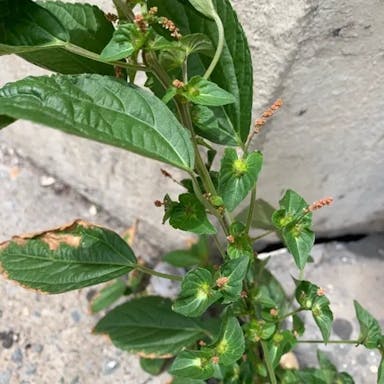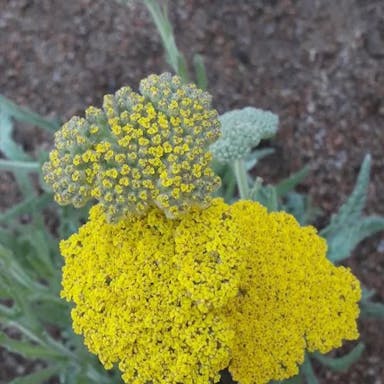Threadleaf giant hyssop, scientifically known as Agastache rupestris, is a plant that belongs to the mint family, Lamiaceae. It is a perennial herbaceous plant that is native to North America, specifically found in the western United States and parts of Canada. The plant is characterized by its thread-like leaves, which are narrow and elongated, giving it a delicate appearance. The flowers of Agastache rupestris are tubular in shape and are arranged in dense spikes at the top of the stems. The flowers are typically a vibrant shade of purple, attracting pollinators such as bees and butterflies. The plant blooms for a long period, with flowers appearing from mid-summer to early fall. Agastache rupestris thrives in well-drained soil and full sun exposure. It can tolerate drought conditions and is resistant to many common pests and diseases. The plant can reach a height of 2 to 3 feet and spreads about 1 to 2 feet wide. It is often used in garden borders, rock gardens, and prairie-style plantings. In terms of symbolism, Agastache rupestris is believed to have healing and purifying properties. It is valued for its ornamental qualities, adding beauty and color to garden landscapes. In summary, Agastache rupestris, or Threadleaf giant hyssop, is a perennial plant native to North America known for its aromatic foliage, long blooming purple flowers and drought tolerance. It adds ornamental value to gardens.
Threadleaf giant hyssop
- Scientific name
- Agastache rupestris
Basic Information
- Lamiaceae Family Agastache Genus Threadleaf giant hyssop Species
- Lamiaceae > Agastache > Agastache rupestris
- 83%
- The Completeness of This Encyclopedia
Please help us complete the encyclopedia, Terrarium is a encyclopedia service to be completed with everyone in the world. Currently, this page is 83% complete. For more information on how to contribute, please click here.
- Forb/herb
- Perennial
- Height
- 60cm ~
- Flower Color
- Leaf Color
- Anthesis
- summer, fall
- Sunlight Exposure
Full Sun Long hours of sunlight from morning to afternoon Partial Shade A location in the shade of a tree or where either the morning or afternoon is shaded Full Shade A place where there is no direct sunlight
- Full Sun
- Hardiness Zones
This is an indicator to know to which zone each plant can winter. Knowing the zone of each plant gives you an idea of the cold temperature resistance when grown in the ground without a roof. 2: -42.7 to -40.0 3: -39.9 to -34.4 4: -34.3 to -28.9 5: -28.8 to -23.3 6: -23.2 to -17.8 7: -17.7 to -12.2 8: -12.1 to -6.7 9: -6.6 to -1.1 10: -1.0 to 4.4 11: 4.5 to 10.0
- 5
- Cold resistance
- Good
- Heat resistance
- Good
- Habitat of origin
- United States
- Growth Rate
- Normal
What is Threadleaf giant hyssop (Agastache rupestris)?
What is Threadleaf giant hyssop (Agastache rupestris)
Flower meaning
The flower language commonly associated with the Threadleaf giant hyssop in America is \
Calendar of Threadleaf giant hyssop (Agastache rupestris)
Calendar
Threadleaf giant hyssop, scientifically known as Agastache foeniculum, is a perennial plant native to the United States. It blooms from middle to end of summer. From July to September, it produces flower clusters that bring in bees and butterflies. In August the flowers are completely open and colorful. Blooming time is around 4 to 6 weeks. To have it bloom longer, you should remove faded flowers often. This makes the plant produce more flowers. Also, give it enough sunlight, well-drained soil, and regular water so it blooms longer.
How to grow Threadleaf giant hyssop (Agastache rupestris)
Watering
The optimal frequency and method of watering for the Threadleaf giant hyssop plant depends on various factors, including seasonal differences, soil humidity, and the specific growth stage of the plant. However, ant love the nectar. Although rain provide water, sunshine help the photosynthesis to produce energy. With proper care, they thrive well in partial shade or full sun location with regular irrigation during dry periods. Overall, maintaining consistent soil moisture without waterlogging is crucial for the optimal growth and health of the Threadleaf giant hyssop plant. Bees are important pollinators..
Soil and Fertilizer
Threadleaf giant hyssop, scientifically known as Agastache foeniculum, thrives in well-drained soil with a pH range of 6.0 to 7.5. For optimal growth, apply a balanced fertilizer with an NPK ratio of 10-10-10 or 14-14-14 in early spring. During the growing season, apply a nitrogen-rich fertilizer every 4 to 6 weeks. Regular soil testing is essential to monitor the nutrient levels and pH. Additionally, maintaining good soil moisture and providing drainage is crucial. By following planting guidelines, you can ensure optimal soil conditions and fertilization for the successful growth of plants. Providing adequate sunlight and water supports healthy plant development. Monitoring for pests helps avoid potential problems. When preparing soil, incorporate organic matter to improve texture. Careful attention to timing of planting and harvesting contributes to higher yields. Factors like weather and disease pressure fluctuate yearly, requiring adjustments to cultivation practices. Recordkeeping allows evaluation of techniques over successive seasons. Focusing on sustainability promotes stewardship of precious natural resources. Prioritizing safety ensures a productive environment for all involved. Honoring time-tested wisdom while integrating new knowledge strengthens agricultural communities.
Sunlight and Place
Threadleaf giant hyssop, a plant with thread-like leaves, has a quite fair cold endurance. It can bear low temperatures to -10°C, making it right for areas with mild to moderate winters. However, it may possibly not make it through in very freezing climates. By comparison, it shows a good heat tolerance, prospering at temps up to 35°C. The best temperature range for this plant is between 20°C and 30°C. In the summer, Threadleaf giant hyssop needs full sun visibility to ensure adequate growth and blooming. It is advised to place it somewhere it can get at least 6 hours of direct sunlight per day. This plant does not have particular needs for overwintering, but it is recommended to give some protection in colder regions. In summary, Threadleaf giant hyssop prefers full sun and can bear a wide variety of temperatures, making it suitable for different climates.
Advanced Information of Threadleaf giant hyssop (Agastache rupestris)
Pruning
Threadleaf giant hyssop, scientifically known as Agastache rupestris, benefits from regular pruning and cutting back to maintain its shape, promote healthy growth, and encourage abundant flowering. Removing dead branches and thinning older stems helps shape and rejuvenate the plant. Frequent grooming keeps hyssop looking tidy by getting rid of spent blooms. Deadheading spent flowers also prolongs the bloom period. Allow the plant time to recover after pruning, and be sure to keep it well watered and fed. Good air circulation is vital, so space plants properly. Proper spacing prevents plants from crowding each other and promotes healthy growth. Hyssop species are hardy, but still require adequate winter protection in cold climates. Adding mulch helps insulate roots against hard freezes.
Planting and Harvest
Threadleaf giant hyssop, also known as Agastache rupestris, is a perennial plant that can be potted or planted in the ground. When potting this plant, it is vital to select a container that is at least 12 inches in diameter and that facilitate drainage. Put compost with drainage in the vessel, leaving adequate space for the plant's roots. Delicately detach the plant from its nursery container and settle it in the pot, ensuring the highest point of the roots is level with the soil surface. Fill up the pot with soil, tightly it gently around the plant. Sprinkle water on the plant thoroughly post-potting and sustain the soil consistently moist, but not waterlogged. If you favor to embed Threadleaf giant hyssop in the ground, select a site with complete sunlight and well-drained soil. Excavate an aperture slightly larger than the plant's roots and settle the plant in the hole, ensuring the highest point of the roots is level with the soil surface. Fill up the hole with soil, tightly it gently around the plant. Sprinkle water on the plant thoroughly post-planting and sustain sprinkling regularly, particularly during arid periods. To repot Threadleaf giant hyssop, pursue the same procedure as potting. Select a slightly larger container and delicately detach the plant from its current pot. Settle it in the new pot, fill up with soil, and sprinkle water thoroughly. Repotting is typically completed every 2-3 years to provide the plant with fresh soil and space for growth. Mishowing, or misplacement, of Threadleaf giant hyssop can happen if it is not given the proper growing conditions. This plant favors complete sunlight and well-drained soil, so situating it in a shady or waterlogged area can guide to poor growth and potential sickness. It is vital to investigate the specific necessities of this plant and provide it with the appropriate environment to prosper.
Propagation
Threadleaf giant hyssop can be propagated using various methods. These include sowing seeds, division, cuttings, and leaf cuttings. To propagate by sowing seeds, collect ripe seeds from the plant. Next, sow the seeds in soil with good drainage in a seed tray or pots. Keep the soil moist. Also, place the tray or pots somewhere warm and sunny. Germination often takes around 2-3 weeks. For division, carefully dig up the plant. Separate the clumps into smaller sections, ensuring each section has roots and shoots. Replant the divisions in well-prepared soil. Keep them adequately watered until they establish. To propagate with cuttings, take 4-6 inch stem cuttings from the plant. Make sure to remove any flowers or buds. Dip the cut end in rooting hormone. Then, plant it in a potting mix with good drainage. Keep the soil moist. Place the pot somewhere warm and bright. Leaf cuttings can also be used for propagation. Take healthy leaves and cut them into sections, ensuring each section has a vein. Plant the leaf sections in a potting mix with good drainage. Keep the soil moist and the pot somewhere warm and bright. Harvesting can be done by cutting the stems just above a leaf node. Be careful not to remove more than one-third of the plant at a time.
Pests and Diseases
Threadleaf giant hyssop (Agastache rupestris), a perennial plant native to rocky prairies and woodlands, needs attention to growing conditions to thrive. Providing full sun exposure, well-draining soil, and adequate but not excessive moisture helps prevent common issues. Regular checks allow early detection and control of sap-feeding insects like aphids. Yellowing leaves may indicate inadequate nutrition. Fast drainage reduces risk of fungal and bacterial problems. When plants struggle despite good care, propagated replacements maintain a healthy planting. Knowledgeable gardeners continually observe and respond to each plant's changing needs. Success requires perseverance through ongoing challenges.
Habitat of Threadleaf giant hyssop (Agastache rupestris)
Habitat
Toxicity of Threadleaf giant hyssop (Agastache rupestris)
Health Benefits
- edible
- Inedible
- Toxic
- No toxicity
NO DATA
Toxic for dogs and cats
NO DATA
Q&A of Threadleaf giant hyssop (Agastache rupestris)
- Is there a recommended way to choose Threadleaf giant hyssop?
Threadleaf giant hyssop, scientifically known as Agastache rupestris, is a perennial plant that belongs to the mint family. New varieties of Threadleaf giant hyssop considered particular qualities important. One popular variant called 'Apache Sunset', which has vibrant orange and pink flowers that prosper summer until fall. Another option, 'Blue Fortune', offers striking blue-violet flowers and draws pollinators resembling bees and butterflies. 'Golden Jubilee' has a reputation for its yellow foliage and purple-blue flowers. When shopping for seeds of Threadleaf giant hyssop, find trustworthy suppliers providing fresh and quality seeds. It is advised to put the seeds inside in early spring and relocate them outdoors after the last frost. For sprouts, select energetic plants through well-built root systems. Avoid seedlings showing yellowing or wilting leaves, because they indicate poor health. Transplant the seedlings into well-draining soil and supply adequate sunlight and water for best growth. By carefully picking varieties, seeds, and seedlings of Threadleaf giant hyssop, you can make sure a successful and exquisite addition to your garden.











